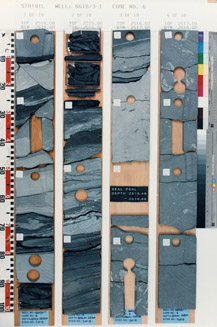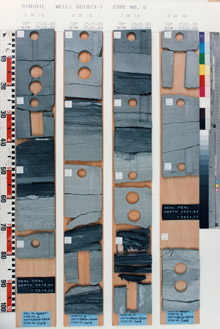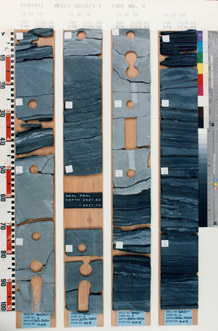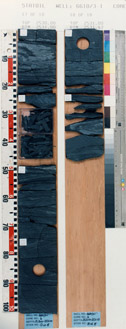Kvitskjæving Member [new]
Shetland Group,
Kvitnos Formation
Introduction
The Kvitskjæving Member is introduced for a unit of interbedded sandstones and mudstones
of Santonian age within the
Kvitnos Formation developed in the south-west Vestfjorden Basin
in block 6610/3 (Nordland III area) of the Norwegian Sea. Limited published data are
available on the depositional setting of these sandstones but they are considered to have been
deposited mainly as turbidites within a submarine fan system in a deep marine, outer shelf to
upper bathyal palaeoenvironment with poorly oxygenated bottom conditions.
Name
English/ Norwegian and any previous names
In the type well 6610/3-1, the interval was informally designated ‘Lysing Sandstone I’ by the
operator Statoil on the final completion log.
Derivatio nominis:
Kvitskjæving is the Norwegian name for the Atlantic white-sided dolphin Lagenorhynchus
albirostris and appropriately, a close relative of the Kvitnos (white-beaked dolphin). It is
endemic to the North Atlantic area. In Norwegian waters, the species is seldom found north of
Trondheimsfjorden and generally in water depths between 40-250m related to the continental
shelf.
Lithology
The Kvitskjæving Member consists of interbedded sandstones and mudstones.
The sandstones are medium grey, clear to transparent quartz, fine to medium, occasionally
coarse, poor to moderately sorted, sub-angular to sub-rounded and calcite cemented,
moderately hard, sometimes argillaceous, micaceous and slightly glauconitic.
The mudstones are light olive grey to black, firm to moderately hard, blocky, partially silty
to sandy, micro-micaceous to micaceous, micro-pyritic, carbonaceous, glauconitic and
moderately calcareous, poor visible porosity.
Basal Stratotype
SEE SECTION 8 (below)
Sample depository
Palynological preparations (organic matter depository)
Type well 6610/3-1: 4 slides from core samples deposited at the NPD covering the interval
2512.2m – 2530.4m (Statoil preparations). Additional micropalaeontological and
palynological slides have been prepared by Robertson Research Int. Ltd. and PetroStrat in the
course of non propriety multi-well studies.
Core photographs
In the type well 6610/3-1 core#6 interval 2514m-2531.47m represents the middle part of the member.
Thickness
The Kvitskjæving Member varies in thickness from 9m to 39m based on released well data.
Isochore map KVITSKJÆVING
Geographical distribution
[Map]
The Kvitskjæving Member is locally developed in the south-westerly part of the Træna Basin
and Vestfjorden Basin (Quadrants 6609 and 6610). Based on released well data it has a
maximum thickness of 39m in the type well 6610/3-1. On the Nordland Ridge and in wells
6610/7-1 and 6610/7-2 located in the Helgeland Basin on the Trøndelags Platform to the
south, the equivalent section is represented by an unconformity. The northerly extent of the
member away from wells 6609/5-1 and 6610/3-1 (original holes and sidetracks) is not
determined due to a lack of well control in the Nordland VI area and the time-equivalent
section in well 6710/10-1 being below the well TD depth.
Occurrences of formation tops in wells
Type well
Well name: 6610/3-1
WGS84 coordinates: N 66°55'29.70, E 10°54'06.28 (figure 2)
UTM coordinates: 7424470.29N 583170.04 E
UTM zone: 32
Drilling operator name: Den norske stats oljeselskap a.s.
Completion date: 17.02.1993
Status: Suspended Re-entered later
Interval of type section (m) & thickness in type well (m):
2543m - 2504m and 39m thickness.
Reference well
None designated. The member was also penetrated in the re-drilled well 6610/3-1 R but this
well provides no additional information on the characteristics of the member compared to the
original hole. In well 6609/5-1 the member is only 9m thick.
Upper and lower boundaries
Upper Boundary
The top of the Kvitskjæving Member is represented by a transition from predominantly
argillaceous sediments of the overlying (and encompassing)
Kvitnos Formation to a sequence
of interbedded sandstones and mudstones. In the type well 6610/3-1 this boundary is
represented by a gradual decease in gamma-ray and increase in sonic velocity values. The
upper boundary is better defined on resistivity logs in the type well where there is a
downward increase in resistivity values.
Lower Boundary
In the type well 6610/3-1, the base of the Kvitskjæving Member is marked by a downward
gradual change from interbedded sandstones and mudstones to more argillaceous sediments of
the underlying Kvitnos Formation. It is characterised on logs by a downward increase in
gamma-ray values and a marked decrease in resistivity values but only a weak increase
decrease in average sonic velocities.
Well log characteristics
[Figure]
The member is characterised by a serrate gamma-ray log profile reflecting the interbedded
sandstone and mudstone content of the unit. The member shows funnel- and bell-shaped
profiles in response to the transitional nature of both the lower and upper boundaries.
Type seismic section
Location of section
[Figure]: ST 9104-437 and SP. 335 (well 6610/3-1)
Section
[Colour Figure]
Biostratigraphy
[Figure]
The Kvitskjæving Member is developed below LO Whiteinella baltica and LO Stensioeina
granulata polonica and between the LO and LCO Chatangiella ‘spinosa’ suggesting an early
Santonian age (Zone 26).
The sporadic records of the Coniacian dino-cyst Florentina deanei above this member in the
type well are considered reworked.
In the cored interval of the type well 6610/3-1 Hystrichosphaeridium difficile shows a
marked increase in numbers within the middle part of the member that maybe useful for
correlative purposes.
Age
Late Cretaceous, early Santonian (Zone 26).
Correlation
The interbedded sandstones and mudstones of the Kvitskjæving Member pass laterally into
the mudstones of the Kvitnos Formation.
The member is time equivalent to some minor and un-named lower Santonian sands
penetrated in the deeper wells in the Vøring Basin e.g. Vema Dome well 6706/11-1 (3737m -
3750mMD RKB) and may suggest a brief and undocumented early tectonic episode
immediately prior to the Campanian - Paleocene rift stage of Færseth and Lien (2002).
Depositional environment
Limited published data are available on the depositional setting of this member. The
sandstones are considered to have been largely deposited as turbidites with a submarine fan
system in a deep marine, outer shelf to upper bathyal palaeoenvironment with poorly
oxygenated sea floor or bottom conditions.
The (above) palaeoenvironmental conditions and depositional setting are indicated by the
recovery of agglutinated and nodosariid foraminiferal microfaunas in cores of the type well
6610/3-1 e.g. 2528.65mMD. These low diversity microfaunal associations are dominated by
deep- water, tubular agglutinated foraminifera (DWAF), particularly Rhabdammina and
fragments of the planktonic mollusc Inoceramus. Pyritised diatoms and nodosariid -
calcareous benthic foraminiferal species are rare e.g. smooth Lenticulina and
Nodosaria spp.
This suggests that some oxygen, but generally in depleted amounts is available on the sea
floor or bottom environment.
Remarks
This member is stratigraphically younger (Santonian) than the Coniacian Lysing Member.
It was referred to informally as the ‘Lysing Sandstone I’ by the operator on the final
completion log of the type well 6610/3-1. On the NPD fact pages, The Kvitskjæving Member
it is only the upper one of two units assigned to the ‘Lysing Formation’ on the NPD fact
pages.
References
Færseth, R. and Lien, T. 2002 Cretaceous evolution in the Norwegian Sea – a period
characterized by tectonic quiescence. Marine and Petroleum Geology, 19, 1005 –1027.






